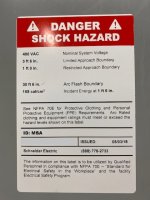The Dude
Member
- Location
- Santa Clarita, CA
- Occupation
- Electrician
How does one open a panel that is over 40 cals? I have read that the appropriate PPE has to be worn to test for absence of voltage. We have a panel that is rated at 169 cal/cm^2 (from a recent arc flash study) that we need to get into. Since there is no PPE for that amount of incident energy (and the company put a 40 cal limit anyway), How do we get into it to replace a breaker? Any clarification is appreciated.

